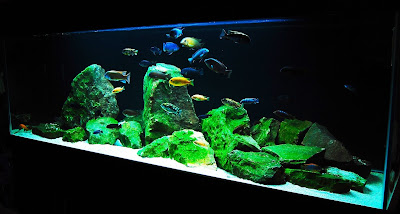As a cichlid keeper, water testing is one thing you ought to do to make sure that your aquarium and its inhabitants are in top shape. However, it is something that requires you to do some homework to know what to get and what to avoid.
The following are basic but must have, test kits you should have to help you maintain your tank’s water quality:
It is important to understand the pH level in your tank’s water, not only for information purposes but also for comparison so you could judge how things are going on in the tank.
The pH scale runs from 0 to 14, and for monitoring tank water you would be measuring in increments of tenths. A pH value of 7 is the midpoint, meaning the water is in neutral condition. Going down the scale from midpoint means the water is getting increasingly acidic. Going up the scale from midpoint means the water is getting increasingly alkaline.
A change of one whole number (up or down the scale) actually represents a change of 100 times. Many aquarium fish from South America prefer softer, more acidic water while those from East Africa thrive well in hard, alkaline water.
Great and rapid changes in pH can be fatal to your fish. Any change greater than 0.2 in a 24 hour period can cause physical stress on the fish that can lower their immune system. Most fish will do fine in a broad range of values, starting as low as 6.5 going up to 8. There are species that can fare better even at higher or lower than these range but it will always be best to allow the pH to settle at a value and leave it there.
Adding salt also reduces parasite infestations since salt interferes with the lifecycles of most external parasites. It can be mixed with the tank water as a therapeutic medication against most parasites, particularly Ich. Most fish can tolerate 1 tablespoon of salt per 5 gallons of water for the 21 days needed to eradicate Ich.
You can use aquarium salt that is readily available in any fish store. Table salt has additives which should not be in the tank. You can also use kosher salt.
The following are basic but must have, test kits you should have to help you maintain your tank’s water quality:
- Ammonia – To measure the amount of ammonia present. This the first phase of the nitrogen cycle and is produced by the wastes of fish, decaying food and other matter. Ammonia can be toxic even at low levels.
- Nitrite – To test the amount of nitrite. This is the second phase in the nitrogen cycle and is produced by the nitrosomonas bacteria.
- pH - To measure the acidity or alkalinity. A reading of 7.0 is neutral and less than 7 is acidic, while over 7 is alkaline.
- General Hardness (GH) – To test the total hardness of water and is most commonly referred to in degrees hardness.
- Carbonate Hardness (KH) – To test the dissolved carbonates, also measured in degrees hardness.
- Nitrate – To measure the amount of nitrate. This is the third step in the nitrogen cycle and is produced by the nitrobacter bacteria converting nitrite to nitrate. There will always be nitrate in an established tank but it’s good to know how much there is in your tank. Water changes and plants help keep it in check.
- Oxygen – To measure the amount of dissolved oxygen. It is best to perform the test periodically to ensure that your cichlids are getting a good supply of oxygen.
- Water Ph Levels
It is important to understand the pH level in your tank’s water, not only for information purposes but also for comparison so you could judge how things are going on in the tank.
The pH scale runs from 0 to 14, and for monitoring tank water you would be measuring in increments of tenths. A pH value of 7 is the midpoint, meaning the water is in neutral condition. Going down the scale from midpoint means the water is getting increasingly acidic. Going up the scale from midpoint means the water is getting increasingly alkaline.
A change of one whole number (up or down the scale) actually represents a change of 100 times. Many aquarium fish from South America prefer softer, more acidic water while those from East Africa thrive well in hard, alkaline water.
Great and rapid changes in pH can be fatal to your fish. Any change greater than 0.2 in a 24 hour period can cause physical stress on the fish that can lower their immune system. Most fish will do fine in a broad range of values, starting as low as 6.5 going up to 8. There are species that can fare better even at higher or lower than these range but it will always be best to allow the pH to settle at a value and leave it there.
Salt Balance In The Tank
Adding salt to the water results in better osmotic balance for the fish. It helps the fish maintain a proper internal/external balance of water). It also reduces or eliminates nitrite toxicity. In a cycling tank, nitrite levels can be quite toxic but adding salt to it will reduce such toxicity.Adding salt also reduces parasite infestations since salt interferes with the lifecycles of most external parasites. It can be mixed with the tank water as a therapeutic medication against most parasites, particularly Ich. Most fish can tolerate 1 tablespoon of salt per 5 gallons of water for the 21 days needed to eradicate Ich.
You can use aquarium salt that is readily available in any fish store. Table salt has additives which should not be in the tank. You can also use kosher salt.

